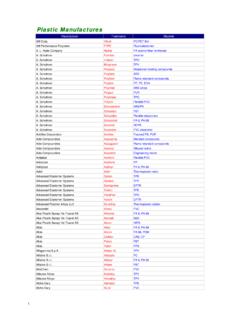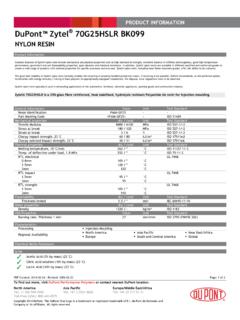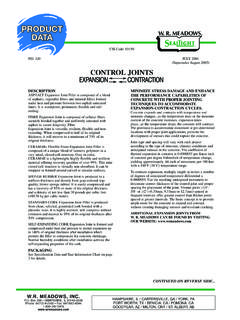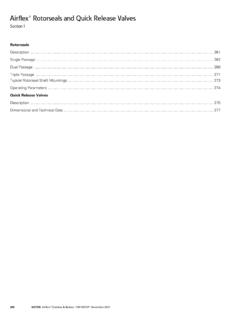Transcription of Snap Fits and Press Fits - engpolymer.co.kr
1 By Warren E. KenneyThe ideal plastic assembly would haveall components joined right in the mold-ing shop. Press or snap fitted together byoperators at the machine, finished prod-ucts would be ready for packaging assembly operations in the automo-tive, machinery or appliance industries areusually a bit more complex, subassembliesfrequently will employ snap and pressfits especially when adequate strength,stiffness and toughness are assured by theuse of such engineering polymers asRynite thermoplastic polyester, Delrin acetal, Zytel nylon, and Hytrel.
2 Incorporating a Press or snap fitinto a design to take advantage of the speedand economies it allows labor reductionand elimination of assembly fixtures,equipment and/or inventories of separatefasteners may be one of the more criticaldecision points in a successful FitsAll snap fits are variations of two basicdesigns, cylindrical (Fig. 1a) orcantilevered lug (Fig. 1b). Both providestrong, easily assembled fits work by using an undercut in onepiece and, on the other, a lip or hook which snaps into the undercut.
3 Assemblyrequires temporary deformation of one orboth pieces, but parts return to anunstressed state in the final assembledposition, thus eliminating the problem ofstress relaxation, an inherent difficultywith Press fits (Fig. 2).Although assembly costs are relatively low,mold costs for snap-fit parts may be some-what high because of complicated cross-sections. This joint generally is not usedwhen a pressure tight or hermetic seal isrequired. Incorporating an o-ring or gasketbetween the parts at assembly can providea degree of Snap JointsCylindrical snap joints can be designed toseparate with ease, with difficulty or notat all, depending on the shaft lead andhub return angle (see Fig.)
4 1a). A shallowreturn angle (30 ) separates easily; a 90 angle is inseparable. An angle of 45 isIdentical halves of split worm gear in Delrin snap together permanently via integral cantilevered fits and Press Fits2typical for most applications. Inseparablejoints are not commonly used because ofthe more complicated mold constructionrequired to provide access to both ends ofthe hub. Generally, a 30 lead-in bevelshould be provided on the shaft to facili-tate hub interference limits to snap fit asteel shaft into a hub of Zytel nylon aregiven in Table 1.
5 Terminology reference isin Fig. the cylindrical shaft or hub sur-faces is an excellent method to reduceassembly forces or stresses. Essentially thecylindrical snap-fit becomes a series ofcantilevered lug snap- fits and the stressesand forces would be calculated using thecantilever formulas. A typical slotted shaftis shown in Fig. requiring high retainingforces, such as the diaphragm valve coverin Fig. 4, can utilize the slot technique togood advantage. The segments are provid-ed with 90 degree undercuts that lock onthe periphery.
6 Disassembly can be achievedby using a tool through access permissible undercut (y in Fig. la) isdetermined by the maximum allowablematerial strain (Emax), expressed as theabsolute = maxDsThe force required to assemble a cylindri-cal hub/shaft is a function of two elements:the force to expand the hub, and the fric-tional force of sliding the shaft into thehub. The forces are combined into oneequation shown below the illustration inFig. LugsThe retaining force of cantilevered lugs isessentially a function of bending 1.
7 Snap-Fit DimensionsFigure of Time on Press andSnap FitsFigure Interference Limits for Press FittingFigure Snap-FitFigure Diaphragm ValveFigure Sized Snap-Fit LugsFigure 1a. Cylindrical Snap-Fit JointFigure LugThey are actually spring applicationswhich are subjected to high bending stressduring assembly. Under working condi-tions, the lugs are either completelyunloaded for moving parts or partiallyloaded in order to achieve a tight cylindrical snap fits , cantilevered lugscan be made to separate easily or not at allby adjusting the return angle (Fig.)
8 1b).Undercuts of 90 degrees can be molded byusing side cores or corresponding slots inthe parts. In the split worm gear of Delrin in the photo (on previous page), two iden-tical parts snap together permanently withcantilevered lugs for increased halves are positioned by two studs fit-ting into mating possible, lugs should bedesigned so that the thickness (h) or width(b) tapers from the root along the will distribute stresses uniformly andreduce the material required for a givenload.
9 Always allow sufficient bendinglength. If the bend length is too short, theroot stresses rise rapidly, breaking the 5 shows a properly sized 1b defines the basic strength anddeflection equations which can be used forcantilevered snap lugs. A note of caution:If high assembly stress or strain is antici-pated, the secant modulus should replacethe more common flexure modulus (E) formore accurate FitsPress fitting can provide a high strengthjoint for metal-to-plastic parts at a mini-mum cost.
10 The large latitude of interfer-ence allowance, due to the lower modulusof plastics, reduces tolerance require-ments and results in increased productioneconomies. However, as mentioned in thesnap-fit discussion, the Press -fit holdingforce will reduce with time due to stressrelaxation (Fig. 2). This force reductionmust be accounted for in the design cal-culations. Typical interference limits forZytel 101 nylon are shown in Fig. fits are normally used to obtainmaximum pullout force.















